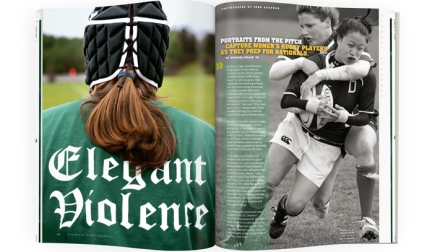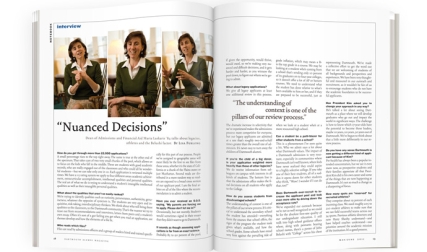The Bonneville Salt Flats is one of the few places on Earth where neither man nor nature will stop you from going as fast as you damn please. Yet before Charles Nearburg could tear across it at more than 400 miles an hour he had to spend a few minutes sitting in perfect stillness, strapped into the driver’s seat of a car that looked more like a missile, waiting for the sun to peek over the nearby mountains because salt flats don’t come with street lights.
Behind him was a General Motors V8 engine with 523 cubic inches of displacement, a monster capable of churning out 1,700 horsepower when stoked by bursts of nitrous oxide. To his side was a steel roll cage, not that it would help much if he cracked up at top speed. Underneath him were four thin tires that looked more suited to a golf cart.
It was September 21, 2010, and Nearburg was gunning for one of motorsports’ most enduring records: The Summers Brothers’ 45-year-old land speed mark of 409.3 miles per hour, the holy grail of its sport. At least 20 teams had tried to break it over the years. All had failed.
Now here was Nearburg—a jovial-but-intense, easygoing-but-borderline-obsessive-compulsive 60-year-old who goes by Charlie—with his lean, 6-foot-3 body fastened into his custom-built streamliner, taking his best shot.
For Nearburg and his crew it was a moment four years in the making. Or maybe four decades. In some ways everything Nearburg had done since his days at Dartmouth—the engineering he learned at Thayer, the fortune he made in the oil business to pay for all this, the hours spent driving race cars of all different stripe—had been a prelude to this. And as he sat in stillness and watched for the sun, his thoughts went to one place.
“I know it sounds hokey,” he says, “but that’s when I really feel Rett’s presence.”
Rett Nearburg came into this world in a hurry, almost as if he knew he wasn’t going to get much time here. It was all his mother could do to stop him from drawing his first breath in the passenger seat of a Volkswagen on the North Central Expressway in Dallas.
Off-the-charts smart, a bit of a hell-raiser, a total gearhead and yet also a gifted artist—just like his old man in most respects—Rett was 10 when he found a lump the size of a quarter attached to one of his ribs. “Then,” Nearburg says, “a doctor you’ve never seen before walks in and tells you in a cold, clinical voice, ‘Your son has cancer and your life is never going to be the same.’ ”
The diagnosis was Ewing’s sarcoma, a rare and nasty bone cancer. Rett had surgery to remove three ribs, then gritted through intense chemotherapy, uncomplaining and undeterred. At one point during treatment he took six Continental Math League tests, becoming one of just 12 students across the nation to achieve a perfect score.
Eighteen months later he was declared in remission. For the next two and a half years Rett and his family—Charlie, Dana and Anna Nearburg ’10—enjoyed a nearly normal existence. Rett caught the winning touchdown in a middle school championship football game. He cheered as his dad drove for NFL legend Walter Payton’s Indy car team and raced at the legendary Le Mans.
And, sure, Rett continued to have scans every six months. Ewing’s survival rates are low upon initial diagnosis, practically nonexistent if the cancer recurs. But the checkups kept coming back clean—until a day in January 1998. Rett immediately went in for surgery.
“Halfway through the doctor came out and said, ‘I’m sorry, it’s back,’ ” Nearburg says with his eyes down, doodling on a scrap of paper as he speaks. “It was my job to go into the recovery room and tell Rett. He was still on anesthesia, but he looked up at me with these big eyes and said, ‘Well?’ And I had to say, ‘Rett, it’s cancer.’ He was 14. He knew what that meant. He just closed his eyes and laid his head back. That was just….”
And there his voice trails off.
To understand what kind of father Nearburg wanted to be, you have to understand what kind of father he had. Gene Nearburg was a classic Texas oilman, hard-drinking and hard-living, so busy making fortunes—and losing them—he didn’t have much time for family.
“You can read into this whatever you want to,” Nearburg says, “but I know a big part of the reason I worked hard to succeed was because I wanted my dad’s approval so badly.”
They bonded over a few things—cars being one of them—and when it came time for college, Gene told Charlie to go to an Ivy League school. Nearburg fell in love with Dartmouth, a place where an engineer could study things beyond engineering. He froze his tail off that first winter, a Texas kid in a polyester parka, but eventually settled in, joining the crew team and Bones Gate, modifying his engineering major with studio art.
After Hanover Charlie tried to distance himself from his father’s path, going into commercial development, then sales, then advertising. But the lure of the family business was ultimately too strong.
He took some geology classes, then told his father he planned to start his own oil and gas exploration operation. In 1978 his father staked him two years’ start-up money—office space and a salary for Charlie and a secretary—in exchange for a half interest in Nearburg Producing Co. Then he told him all the ways not to screw up.
By 1982, after a series of small successes, Nearburg had a hunch about the geology under a claim south of Roswell, New Mexico, sunk everything he had into it—and a lot he didn’t—and hit it big. Huber Federal No. 1, which Nearburg operated himself, became one of the most productive wells in New Mexico history.
Although he was living in a tiny 1908 Craftsman house, sans central air, Nearburg rolled all the profits back into his business. It soon became one of America’s top-50 independent exploration and production companies. He had some misses. But not many.
“He’s very calculating in everything he does,” says Duane Davis, the chief operating officer of Nearburg Producing Co. “This is a high-risk business, but if you do your homework you reduce the risk quite a bit. And Charles always does extra homework.”
It is perhaps an odd mix: A seat-of-the-pants, thrill-seeking race car driver and a meticulous, detail-oriented engineer. But that’s Nearburg.
“He sets land speed records in everything he does,” says Arnie Holtberg, the headmaster at St. Mark’s School of Texas in Dallas, where Nearburg has been a trustee for 20 years. “Charlie is one of the most determined, goal-oriented people I’ve ever met.”
And yet when it came time to face his most significant challenge—the illness of the son he loved and doted on the way his own father never did—Nearburg was about to learn that despite all his resources and determination, he was utterly powerless.
For seven years Rett spent half his life in hospitals around the country, participating in phase 1 drug trials and early forms of gene therapy, at times making himself a guinea pig for researchers. The pattern became achingly familiar: Find a tumor, shrink it, remove it. All told, he had 13 major operations.
“After the sixth or seventh surgery, when they had literally sliced Rett from sternum to backbone, Charlie told Rett, ‘You know, if you want to knock this off and just live a little, that would be fine,’ ” says Mark Nearburg, Charlie’s brother and best friend. “And Rett said, ‘If there’s any way what I’m doing can help someone else someday, I’m keeping going.’ ”
During one of the lulls between hospital stays, in 2003, Rett enrolled at Maryland Institute College of Art (MICA). For one of his projects he used homemade parts to rig a respirator to an out-of-focus computer camera that was aimed at the word “NOW.” He invited classmates to wear the respirator, and when they breathed in, the camera went into sharp focus and the word “NOW” grew crisp and bold. The students knew Rett had cancer. The significance—the breath of life, the immediacy of living, the importance of staying in the now—was lost on no one.
Rett lasted only one semester at MICA before cancer forced him to withdraw. He did an experimental treatment in San Antonio, Texas, that seemed to work for a time. But by the end of 2004 he was struggling, so exhausted he spent most of a New Year’s trip to New Orleans in the hotel. His parents thought maybe he had a lung infection, a constant fear—Rett’s right lung had been destroyed by radiation and surgery, leaving him solely reliant on his left one.
On the morning of January 14, 2005, he had a bronchoscopy and another scan. As Rett was moved into the recovery room, doctors showed the Nearburgs the results. “As soon as they flashed the scan up, Dana and I broke down,” Nearburg says. “By that point we could read the scans as well as the doctors. His left lung was just full of tumors.”
The Nearburgs began calling friends and family to Rett’s hospital room. For the next several hours streams of visitors came in to hold hands and say prayers. Rett died that evening. He was 21.
How do you move on from the worst thing that ever happened to you? How do you construct a new reality that doesn’t involve the constant intensity of life-or-death decision-making? How do you overcome the guilt of living while your son is dead?
For the next year and more Nearburg agonized over those questions. He and Dana found themselves unable to configure a post-Rett existence and went through an amicable divorce. He distracted himself with his business and numerous hobbies: fly fishing, motorcycle riding, cancer research fundraising (including an international symposium for Ewing’s researchers in Rett’s name), flying (a licensed pilot, he frequently commutes between homes in Dallas and Lebanon, New Hampshire), woodworking, car collecting, staying active with Dartmouth as a Thayer overseer and a crew team steward. There’s a reason Barry MacLean ’60, Th’61, also a longtime Thayer overseer, calls him “a Renaissance man in every sense of that phrase.”
Through it all Nearburg’s thoughts kept going to Bonneville. He had never been there but was long fascinated by the pursuit of pure speed on the densely packed salt pan in northwestern Utah. And watching Rett had taught him not to leave things undone.
“You learn life is really a day-to-day experience,” Nearburg says. “You’ve got to have a forward vision and you’ve got to delay gratification if you want to accomplish anything meaningful. But you’ve also got to wake up every day, make the most out of it and never let the sun set on regret. That’s how Rett lived his life and that’s how I try to live mine.”
At the end of 2006 Nearburg purchased a used streamliner and named it The Spirit of Rett. He discovered trying to break land speed records was not only a great way to honor his son, it was also pretty good therapy. He got busy hiring a crew to rebuild the car from stem to stern, sweating the details in true Nearburg fashion.
There are no corporate sponsors at Bonneville, no prize money. Just trophies. The costs, which easily run into the hundreds of thousands of dollars, are high: Nearburg won’t say what he spends per year, only that it’s less than his annual contribution to Dartmouth. The stakes are higher.
“If things go wrong at 400 miles an hour, they go wrong in a hurry,” says Lee Ryan, Nearburg’s crew chief. “You’re talking about a car that is 33-feet long but only 3 feet wide, so it has a tendency to get a little bit of a yaw. If it rolls, there’s virtually nothing to stop it rolling.”
Or there was the time in 2007 when the car’s parachute failed to deploy. Calling on all his driving experience, Nearburg worked the brakes judiciously until they literally melted from friction. With 100 yards to go before hitting Interstate 40, he was still traveling 120 miles an hour, flames shooting from the back tires. By carving a series of wide turns he stopped just short of the highway.
Less than an hour later he was back in the car, with the parachute repacked but no brakes, ready for another run. How? Simple, says Ryan: “He’s got balls of cast iron.”
By 2010 The Spirit of Rett had broken a number of land speed records, including the fastest gasoline-powered car and the fastest two-wheel-drive car. But the Summers Brothers’ record for fastest non-aspirated car—viewed as Bonneville’s heavyweight championship—was still out there.
Heading into the September meet the team was still fretting over certain particulars, including the gear ratios. Chuck Horrell ’00, Th’01, who met Nearburg through Thayer’s Formula racing team—Nearburg is a team mentor, driving coach and sponsor—had joined the crew for Bonneville. He and Ryan debated gear ratios for two days. If they chose too low a number, the car might not go fast enough. If they went too high, the engine wouldn’t have enough power to turn.
“Charlie just pulled a number out of the air,” Horrell says. “Charlie’s whole life seems to be about making very important decisions based on incomplete data sets. And yet he always makes the right one. Is that magic or some form of intuition? I don’t know.”
Nearburg calls it a SWAG—a scientific wild-ass guess.
Then again, it’s not all guesswork. Knowing his engine works best at lower temperatures (cold air is oxygen rich) but higher humidity (water also contains oxygen), Nearburg consulted aviation forecasts, waiting through the entire first day of the September meet. Other teams went out, burned up their engines and went home.
Nearburg didn’t roll until the second day, when he knew conditions would be ideal. At first light his crew pushed him off. The first run went perfectly—the gear ratio was right on—and Nearburg blazed through the timed mile at an average of 417.6 miles an hour.
But there was still the matter of the second run. Official records factor the average of two passes, done in opposite directions within one hour, and only count if the average improves the existing mark by 1 percent. As salt conditions degraded in the heat of day Nearburg had problems getting traction with those skinny tires. He went through the timed mile with the engine 250 rpms below maximum.
It wasn’t until the safety crew arrived, horns honking, that Nearburg learned the second run had been timed at 411.7. With an average speed of 414.3, The Spirit of Rett had broken the record by 1.2 percent. Nearburg’s crew members came next, not that he could fully see them. He was already crying.
“At that point I just closed my eyes,” he says, “and said another prayer to Rett.”
Brad Parks is an author, most recently of Eyes of the Innocent (St. Martin’s Press), and a frequent DAM contributor.




